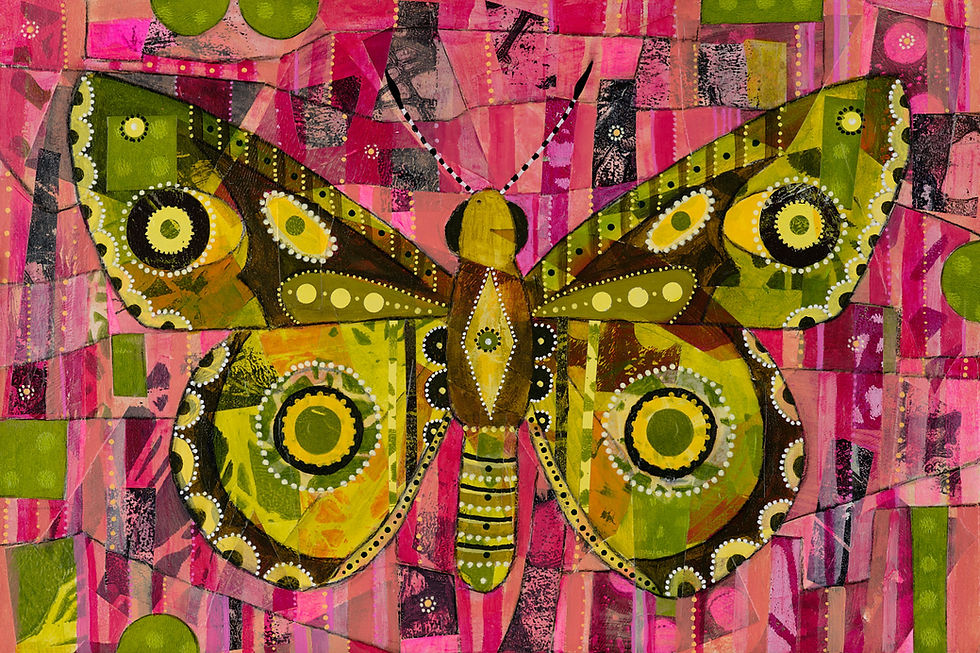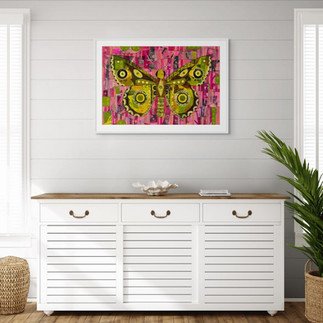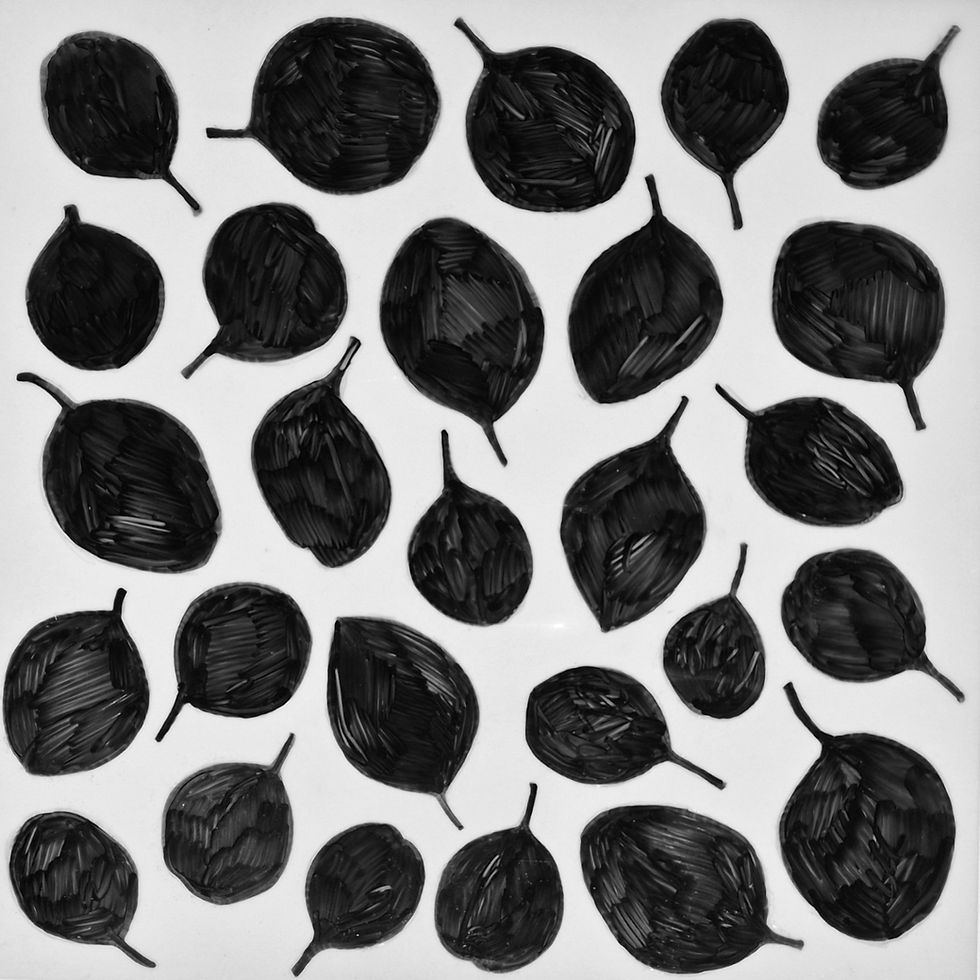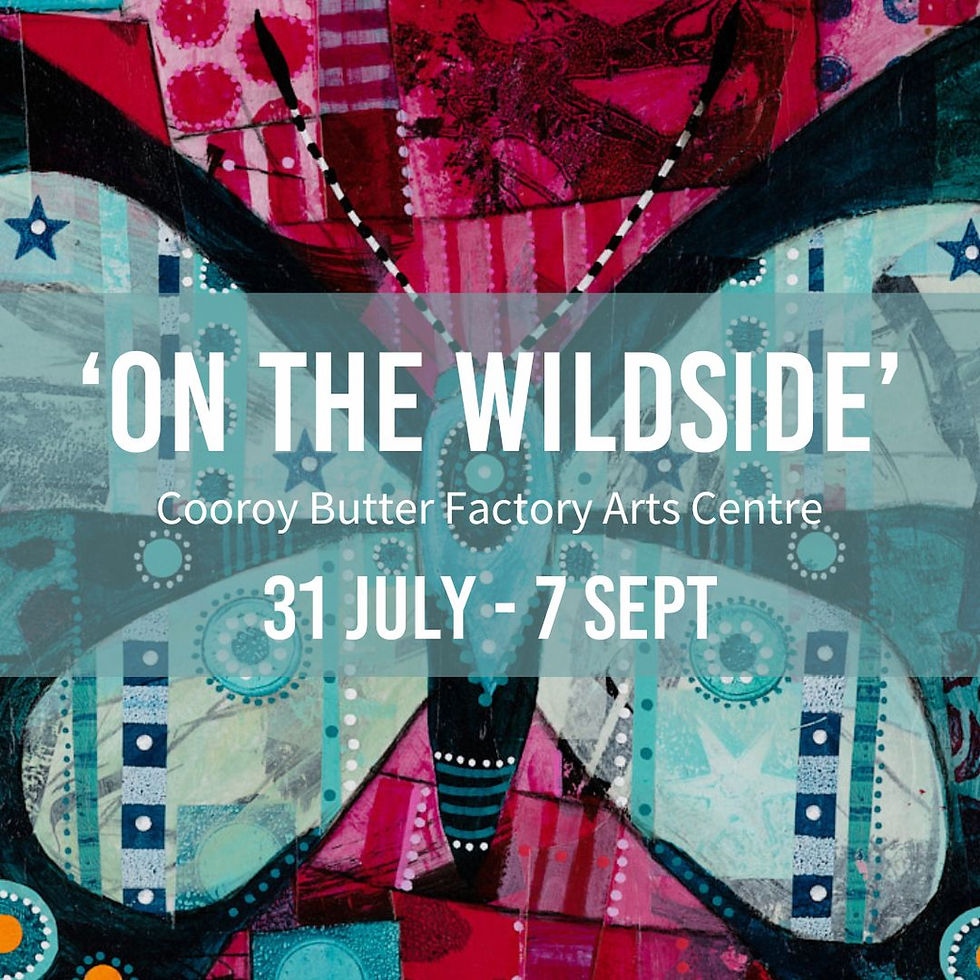Reflecting on Beauty and Vulnerability in the Legacy Series: Nature Inspired Art
- Charlotte Wensley
- Jul 29
- 9 min read
Updated: Dec 5
This collection of nature inspired artworks was commissioned for the 'On the Wildside' exhibition at the Butter Factory Arts Centre in Cooroy. The concept of this group show is to celebrate the beauty and rich diversity of wildlife and their habitats, across various themes including wild spaces, aquatic environments, winged creatures and vulnerable species.

This is a visually rich exhibition of artworks by local artists that bring to life diverse elements of the vibrant ecosystems that surround us.
There are notable and high profile mammal species that are at risk globally, but I chose to explore my backyard and look at Australian creatures, and subsequently the smallest beings that are essential to our survival as a human species, as they act on a macro level to ensure both the physical health of our ecosystems and the productivity and sustainability of our food plants due, in part, to their role as pollinators.
There are 14 paintings in this collection (2025).
| The Plight of Australian Butterflies
Australia is home to 26 species of moths and butterflies teetering on the brink of extinction. These delicate creatures often depend on specific host plants and intricate relationships with ants, making them incredibly vulnerable to even the slightest environmental changes.

| Magnificent Moths in Decline
Australia boasts a stunning array of moth species, yet many are now endangered, facing threats from habitat loss, invasive species, and climate change. The Golden Sun Moth, once a common sight across southern Australia, now struggles to survive as its native grassland habitat dwindles.
| Beetles on the Brink
Recent data reveals that over 60 beetle species in Australia are listed as threatened, spanning categories from vulnerable to critically endangered. These fascinating insects play crucial roles in our ecosystems, yet they face mounting threats from habitat destruction and environmental changes.
However, only a small number (fewer than 10) are listed under the national Environment Protection and Biodiversity Conservation Act 1999 (EPBC Act), which is Australia's main environmental legislation. These include:
Bornemissza’s stag beetle – Critically Endangered
Broad-toothed stag beetle – Endangered
Both species are important indicators of forest health, and their protection is closely tied to the conservation of Australia’s remaining native woodlands.
Many other species are considered at risk at state or regional levels but have not yet been assessed nationally. Australian beetle diversity is vast and still under-documented, so it's likely that many more species are in decline but unlisted due to a lack of data.
| The Paintings
Through this work, I wanted to capture the intricate beauty and delicate existence of a select group of endangered and vulnerable Australian moths, butterflies, and beetles.
These artworks are not only a celebration of the beauty of these creatures but also a poignant reminder of their vulnerability. The bold colour combinations pay tribute to them but also serve as a call to action to save these species.
These insects are essential components of our delicate planetary ecosystem, of which we are all a part and are in a highly precarious position; human induced disruption to their habitat has become the greatest threat to their survival.
I have titled the series 'Legacy' to honour what is at risk, and evoke sentiment about that which is precious being passed down - or tragically lost. These insects are part of Australia's natural heritage and deserve to be protected for future generations.
The word 'Legacy' has a strong emotional resonance for me too; it invokes depth of feeling, of something becoming a memory, and carries with it a sense of responsibility. It speaks to me of tribute, and relevance beyond the moment; even as a species faces extinction my paintings become part of their ongoing story and history.
I am honouring the tradition of artists who preserve beauty, tell overlooked stories and leave a timeless and creative legacy through their work.
July 2025
| Apollo Jewel

The Apollo Jewel butterfly is a beautifully iridescent species native to eastern Australia, primarily found in coastal heathlands and open forests of Queensland and northern New South Wales.
Its caterpillars feed on young shoots of Acacia species and rely on a symbiotic relationship with certain ant species for protection.
The Apollo Jewel is currently listed as 'Endangered', with its survival threatened by habitat loss, inappropriate fire regimes, and urban development.
Conservation efforts aim to preserve native vegetation and support the ecological relationships crucial to its life cycle.

| Australian Fritillary

The Australian Fritillary butterfly is one of Australia's rarest and most threatened butterflies. Once found along coastal swamps and heathlands of southeastern Queensland and northern New South Wales, it has suffered severe population decline due to habitat destruction and the loss of its host plant, the native violet.
It is now listed as 'Critically Endangered', and may already be extinct in the wild, with only a few unconfirmed sightings in recent years. Conservation efforts are focused on habitat restoration and surveys to determine if any viable populations remain.

Original - SOLD
| Bank's Brown

This is a little-known species native to the alpine and subalpine grasslands of southeastern Australia. It has distinctive eye spots that help it camouflage among the grasses. This butterfly is highly dependent on undisturbed native grassland ecosystems, making it particularly vulnerable to habitat loss from grazing, weed invasion, and climate change.
Its restricted range and specialised habitat requirements have led to concerns for its long-term conservation. It is listed as ‘Critically Endangered’ under the EPBC Act.

| Bornemissza's Stag

This beetle, found only in the cool, wet forests of northwestern Tasmania, is named after the Hungarian-Australian entomologist George Bornemissza.
Distinguished by its large mandibles, this ground-dwelling beetle plays a crucial role in the forest ecosystem by breaking down decaying wood.
It is listed as ‘Endangered,’ facing major threats such as habitat loss from logging, land clearing, and changes to forest moisture levels.
Conservation efforts are focused on protecting old-growth forest habitat and maintaining suitable microclimates.

The original painting is on show in the Members Gallery at the Cooroy Buttery Factory Arts Centre 19th November 2025 to 3rd January 2026.
| Broad-toothed Stag

This small stag beetle is just 13mm to 18mm in length and endemic to Tasmania, occupying wet eucalypt forest in an area centred in Wielangta Forest in eastern Tasmania. It plays a vital role in Tasmania’s native forests as a decomposer. Its larvae feed on decaying wood, helping to break down dead trees and recycle nutrients back into the soil, which supports healthy forest ecosystems.
As part of the food web, it also provides sustenance for birds and other wildlife. It is one of the rarest animals in Australia and is listed as 'Endangered' under the Tasmanian Threatened Species Protection Act 1995. Protecting this endangered beetle means preserving the ecological balance of the forests it inhabits.
The major threat facing the Broad-toothed Stag Beetle is habitat loss, predominantly through clearing and forestry practices. Approximately 20% of forest cover within the species area of occurrence has been cleared since European settlement, primarily for grazing.
Ongoing threats include, extensive conversion of native forest to plantation forest, frequent or hot burns leading to loss of ground litter layer and decaying logs, targeted removal of decaying logs, including firewood collection or heaping for burning.

| Bulloak Jewel

The Bulloak Jewel butterfly is a rare and strikingly iridescent species found in parts of inland Queensland and New South Wales. It has a close relationship with bulloak trees (a type of Casuarina), which its larvae depend on for food and shelter. The butterfly is currently listed as 'Endangered' due to habitat clearing, fragmentation, and the decline of ant species that help protect its caterpillars. Conservation efforts are focused on preserving bulloak woodlands and maintaining the delicate ecological interactions that support this unique butterfly’s survival.

| Golden Rayed Blue

This species is found only in a small area of South Australia within a very limited range and is dependent on specific host plants, including native mistletoes, for its survival. Due to its restricted distribution and the threat of habitat loss from land clearing and grazing, the Golden Rayed Blue is listed as ‘Endangered’ under the EPBC Act. Conservation efforts aim to protect its habitat and food plants to ensure the species’ survival.

| Golden Sun Moth

This is a day-flying moth native to temperate grasslands in southeastern Australia. Males are known for their golden-brown forewings and bright orange hindwings, while females are larger and flightless, spending much of their lives on the ground. Once widespread, this species is now listed as ‘Critically Endangered’ due to extensive loss of native grasslands from agriculture and urban development. The moth relies on native tussock grasses for its entire life cycle, making habitat protection vital for its survival.

Original - SOLD
| Pale Imperial Hairstreak

This is a small butterfly, native to the dry open woodlands of Queensland and New South Wales. This species has a close association with native ants, which tend its caterpillars in a mutualistic relationship. Once more widespread, the Pale Imperial Hairstreak is now listed as ‘Endangered’ largely due to habitat loss from land clearing and the decline of its host plant, the native Acacia species. Conservation efforts are focused on habitat restoration and protecting remnant woodland ecosystems.

| Richmond Birdwing

This is Australia's largest subtropical butterfly, native to the rainforests of southeast Queensland and northeast New South Wales. Once widespread, it is now listed as ‘Vulnerable’ due to habitat loss, fragmentation, and the impacts of climate change, including prolonged droughts and rising temperatures. Its survival is further threatened by the introduction of the toxic Dutchman’s Pipe vine, which the butterfly mistakenly lays eggs on instead of its native host plant—resulting in caterpillar deaths. These pollinators have an impressive wingspan of 13 to 16 centimetres.

| Sapphire Azure

The Sapphire Azure Butterfly is a small, shimmering species with brilliant blue wings, found in parts of southeastern Australia. It has a highly specialised life cycle, with caterpillars that depend on a species of mistletoe and form mutualistic relationships with specific ant species for protection. The butterfly is listed as 'Vulnerable', primarily due to habitat loss, land clearing, and declines in its host plants and ant partners. Conservation efforts focus on protecting mistletoe-bearing host trees and maintaining the intricate ecological networks that support its survival.

The original painting is on show in the Members Gallery at the Cooroy Buttery Factory Arts Centre 19th November 2025 to 3rd January 2026.
| Small Alpine Xenica

This rare and delicate butterfly is found only in the alpine and subalpine regions of southeastern Australia, particularly in Victoria and parts of New South Wales. This species is specially adapted to cold, high-altitude environments and relies on native alpine grasses for food and breeding. Due to its restricted habitat and sensitivity to climate change, it is listed as ‘Critically Endangered’ in Victoria with warming temperatures and habitat disturbance posing significant threats to its survival.

| Small Bronze Azure

This is a delicate and elusive species found in parts of southeastern Australia, particularly in dry sclerophyll forests and woodlands. This butterfly has a fascinating relationship with ants, which protect its larvae in exchange for sugary secretions. The Small Bronze Azure is considered ‘Vulnerable’ due to habitat loss, land clearing, and the decline of native ant populations essential to its life cycle.

| Yellow Sedge Skipper

The Yellow Sedge Skipper is a small, fast-flying butterfly native to coastal wetlands in eastern Australia. It depends on sedge plants that typically grow in wet or damp environments, such as marshes, wetlands, and along streambanks, for its larval food source and habitat. Once more widespread, it is now listed as 'Critically Endangered', with its population drastically reduced due to wetland drainage, coastal development, and habitat fragmentation. Conservation efforts are focused on restoring native sedgelands and managing invasive species to support the remaining populations.

| Final Thoughts
These remarkable species are vital indicators of ecosystem health, underscoring the urgent need for their protection. By safeguarding them and highlighting them through nature inspired art, we ensure the preservation of our planet's rich biodiversity and the delicate balance of our natural world, on which we all depend.
Find out more about the exhibition here
SHOP the Legacy Collection Originals & Prints here
For more information about work on consignment to galleries download the catalogue below, browse available original paintings in our Shop and check out our range of beautiful reproduction prints.
*Free Worldwide shipping on all original paintings and unframed prints
| Join My Art Community
Don't forget to join my Studio Diary mailing list to get my monthly newsletter delivered straight to your inbox and your free PDF copies of my
Top 10 Tips - COLLAGE BASICS
Top 10 Tips - GELLI BASICS
Top 10 Tips - MEDIUMS and GELS
Follow the link to get your copies today!
#contemporaryabstractart #charlottewensleyart #abstractart #artvideo #artprocessvideo #abstractartprocess #australianart #contemporaryart #modernabstractart #modernart #charlottewensley #artblog #abstractartblog #artblogs #gelliprinting #gelliprint #artmakingvideo #artvideo #artmaking #newabstractart #abstractpaintings #gelliprintcollage #abstractartist #abstractartblog #mixedmediaart #mixedmedia #mixedmediaabstract #abstractmixedmedia #mixedmediaartist #mixedmediavideo #collageart #collage #modernabstracts #sketching #australianartist #artforinteriors #artistsvlog #abstractpainting #colouranddesign #originalabstractart #buyoriginalart #buyabstractart #artinnoosa #queenslandartists #noosaartist #australianartists #australianart #brisbaneartist #brisbaneart #melbourneart #artgalleries #artprints #surfacedesign #productdesign #homedecor #wallart #framedartprints #artprintoncanvas #wildlifeart #butterflyart
Sources:

















